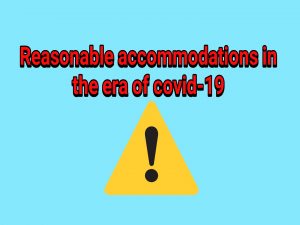When the coronavirus pandemic started taking hold in the New York region, government moved to shutdown businesses to help control the spread of the virus. New York State Governor Cuomo instituted the Pause program which required all non-essential businesses in New York to close. But, essential businesses were allowed to stay open.
Almost immediately, employment lawyers across the state, including our Long Island employment lawyers at Famighetti & Weinick PLLC, were inundated with calls from essential workers worried about contracting covid-19 from the workplace. We blogged about these concerns and also posted a video about these issues.
As New York begins to emerge from the Pause and the economy is set to re-open, questions still remain about the rights of vulnerable segments of the workforce safely returning to work and the rights of other workers who are concerned about contracting the virus. Today’s Long Island employment law blog discusses some of these concerns, with a focus on the EEOC’s latest guidance issued on May 5, 2020.
Covid-19 and workplace safety generally implicates two federal laws. OSHA specifically regulates workplace safety. Our previous blogs and videos have discussed the four step process which employees can use to determine whether they can refuse to work because of an unsafe workplace.
The Americans with Disabilities Act (ADA) is the other law which plays an important part in establishing rights for vulnerable workers, or workers with underlying medical conditions worried about contracting coronavirus. The ADA requires that employers provide reasonable accommodations for employees’ medical conditions. Employees must have an underlying medical condition which legally constitutes a disability under the law, to qualify for protections under the ADA. Workers with generalized fears or anxiety about workplace covid-19 exposures likely are not protected by the laws discussed in this blog.
In its May 5th guidance, the EEOC emphasized that the duty to request an accommodation is on the employee. In other words, employers are not required to guess, assume, or make their own independent assessments about whether an employee needs a reasonable accommodation. Rather, the employee must make clear to the employer that he or she needs a change of working conditions to accommodate a medical condition. The employee, however, does not need to use magic words such as reasonable accommodation or specifically reference the ADA. The employee need only make clear to the employer the need for an accommodation based on a medical condition.
After making the request, the employer may request medical documentation to assist in determining the nature of the medical condition and how the employer can accommodate the employee. The employer may also ask follow up questions of the employee. These inquiries can assist in determining the nature of the disability and whether an accommodation can be made.
The tougher question in accommodations cases is what kind of accommodation is reasonable. Employers need only provide accommodations which are reasonable and which do not pose an undue hardship on the employer. An extreme example would be that an employer is likely not required to build a hermetically sealed isolation chamber for the employee to work in. But, it is likely reasonable for the employer to provide masks, gowns, and face shields.
Indeed, the EEOC specifically notes that reasonable accommodations may include erecting barriers, reassigning portions of an employee’s work duties, modifying work schedules, or moving work locations.
An important, but understated point made by the EEOC guidance is that employers are not required to completely eliminate the threat of covid-19 for a vulnerable worker (at least under the ADA). The EEOC directs that employers do not have to completely eliminate the threat, but may instead reduce the threat to “an acceptable level.”
This guidance coincides with our opinion about whether OSHA requires elimination of the threat of covid-19. In previous blogs, we shared our belief that OSHA also does not require elimination of the threat of spread of covid-19, but requires only that employers take steps to protect employees. Thus, employees should not expect that employers will guarantee that workers will not be exposed to covid-19 in the workplace and employers can rest assured that, at least under the ADA, they do not have a duty to eliminate the risk of exposure. Employers must only mitigate the risk. Failure to do so can expose employers to failure to accommodate claims under the ADA.
The law is constantly evolving concerning workplace covid-19 issues. The EEOC is regularly issuing new, and revising old guidance to help employers and employees navigate the complex questions arising from the covid-19 pandemic. We are watching the developments and will share the EEOC’s guidance and our own thoughts, as the issues develop.
Whether related to coronavirus or not, reasonable accommodation cases are difficult because “reasonable” is not easily defined and varies drastically from case to case. If you are a high risk worker with underlying medical conditions and require an accommodation from your employer, contact one of our Long Island employment lawyers to discuss your situation. We offer free consultations and oftentimes, a reasonable accommodation inquiry requires no more than taking advantage of our free initial consultation. Call 631-352-0050 to speak with an experienced Long Island employment lawyer today. Be sure to follow us on social media to stay updated on employment law issues arising in the age of coronavirus.

Reasonable accommodations under the ADA and coronavirus
 Long Island Employment Law Blog
Long Island Employment Law Blog

